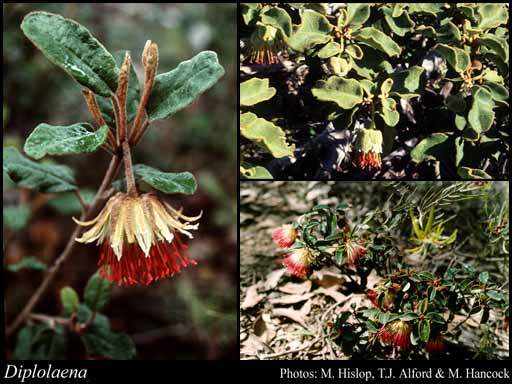- Reference
- Voy.Terra Austral. 2 (1814)
- Name Status
- Current







Scientific Description
Family Rutaceae.
Habit and leaf form. Shrubs; evergreen, or deciduous; bearing essential oils. Mesophytic, or xerophytic. Leaves alternate; leathery, or ‘herbaceous’; petiolate; non-sheathing; gland-dotted; aromatic; simple. Leaf blades entire; pinnately veined, or one-veined. Leaves without stipules, or with stipules. Stipules when present, intrapetiolar; represented by glands. Leaves without a persistent basal meristem. Leaf anatomy. Hairs present; complex hairs present. Complex hairs stellate. Stem anatomy. Nodes unilacunar, or tri-lacunar. Secondary thickening developing from a conventional cambial ring.
Reproductive type, pollination. Fertile flowers hermaphrodite. Unisexual flowers absent. Plants hermaphrodite. Entomophilous.
Inflorescence and flower features. Flowers aggregated in ‘inflorescences’; in cymes. The terminal inflorescence unit cymose, or racemose. Inflorescences terminal, or axillary, or epiphyllous; dense, surrounded by 3–4 rows of appressed imbricate bracts, the inner petaloid. Flowers sessile; bracteate; bracteolate, or ebracteolate; small to medium-sized; fragrant; regular, or somewhat irregular. The floral asymmetry when noticeable, involving the perianth and involving the androecium (not K). Flowers usually 5 merous; cyclic. Floral receptacle developing a gynophore (associated with the disk), or with neither androphore nor gynophore. Free hypanthium absent. Hypogynous disk present (lobed); intrastaminal; annular (sometimes one-sided), or of separate members. Perianth petaline; 5; 1 -whorled; isomerous. Calyx absent. Corolla usually 5; 1 -whorled; polypetalous; imbricate (the odd petal anterior); regular, or unequal but not bilabiate. Petals linear. Androecium 10 (or more). Androecial members unbranched, or branched (? by the splitting of simple primordia); free of the perianth; all equal, or markedly unequal; free of one another, or coherent (? the filaments usually more or less basally connate); 1 - adelphous, or 3–12 - adelphous; 1 -whorled, or 2 -whorled. Stamens 10 (or more); diplostemonous; alternisepalous. Filaments hairy (long-pilose within towards base). Anthers dorsifixed, or basifixed (? more or less); versatile; dehiscing via longitudinal slits; introrse, or latrorse; tetrasporangiate; appendaged; minutely glandular- apiculate. Gynoecium 5(–8) carpelled. The pistil when syncarpous, 5(–8) celled. Gynoecium apocarpous, or syncarpous (? carpels not apiculate); eu-apocarpous, or synstylous; superior. Carpel stylate. Style subulate, more or less equal to stamens. Carpel (when apo- or semicarpous) (1–)2–100 ovuled. Placentation of the free carpels marginal. Ovary plurilocular; when syncarpous, 5(–8) locular. Styles 1, or 3–5; free, or partially joined; apical. Stigmas shortly 5 - lobed; wet type, or dry type; papillate, or non-papillate; Group II type, or Group IV type. Placentation when syncarpous, axile. Ovules 1–5(–50) per locule; pendulous to ascending; epitropous; when two or more per cell, collateral, or superposed, or biseriate; arillate, or non-arillate; anatropous, or hemianatropous.
Fruit and seed features. Fruit fleshy, or non-fleshy; an aggregate, or not an aggregate. The fruiting carpels coalescing into a secondary syncarp, or not coalescing. The fruiting carpel dehiscent, or indehiscent; baccate. Fruit a schizocarp. Mericarps when schizocarpic, comprising berrylets, or comprising follicles, or comprising nutlets, or comprising drupelets. Seeds reniform to oblong; endospermic, or non-endospermic. Embryo well differentiated. Cotyledons 2. Embryo chlorophyllous, or achlorophyllous; straight, or curved, or bent. Testa smooth. Seedling. Germination phanerocotylar, or cryptocotylar.
Physiology, biochemistry. Aluminium accumulation not found. Photosynthetic pathway: C3.
Geography, cytology, number of species. X=13 or 14. A genus of 15 species.
Taxonomic Literature
- Wheeler, Judy; Marchant, Neville; Lewington, Margaret; Graham, Lorraine 2002. Flora of the south west, Bunbury, Augusta, Denmark. Volume 2, dicotyledons. Australian Biological Resources Study.. Canberra..
- Grieve, B. J.; Blackall, W. E. 1998. How to know Western Australian wildflowers : a key to the flora of the extratropical regions of Western Australia. Part II, Dicotyledons (Amaranthaceae to Lythraceae). University of W.A. Press.. Nedlands, W.A..
- Wilson, Paul G.; Armstrong, J. A.; Griffin, E. A. 1998. Diplolaena (Rutaceae), a new taxa and nomenclatural notes.
- Marchant, N. G.; Wheeler, J. R.; Rye, B. L.; Bennett, E. M.; Lander, N. S.; Macfarlane, T. D.; Western Australian Herbarium 1987. Flora of the Perth region. Part one. Western Australian Herbarium.. [Perth]..